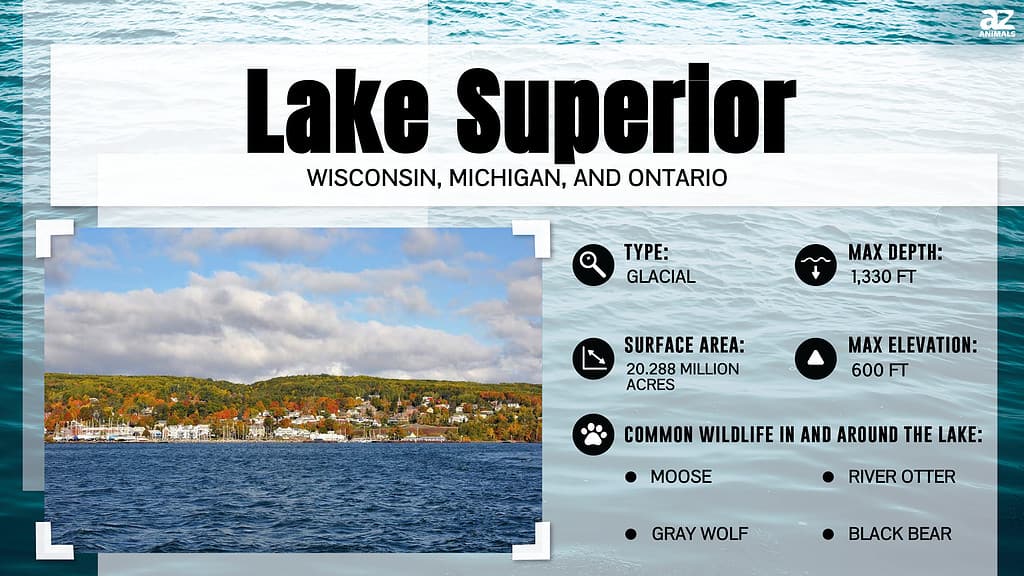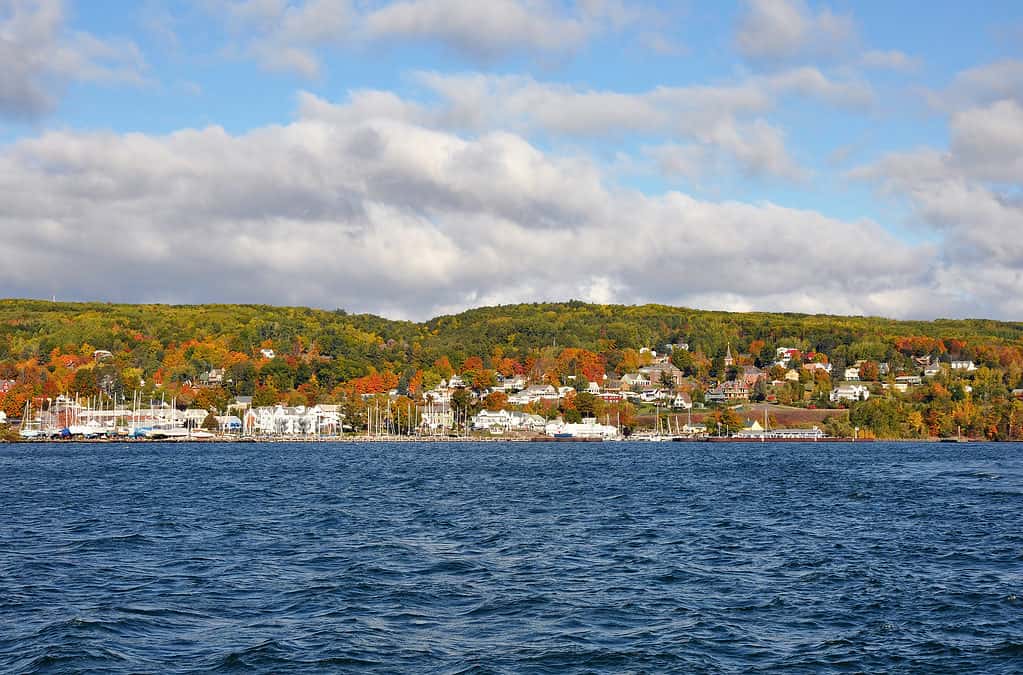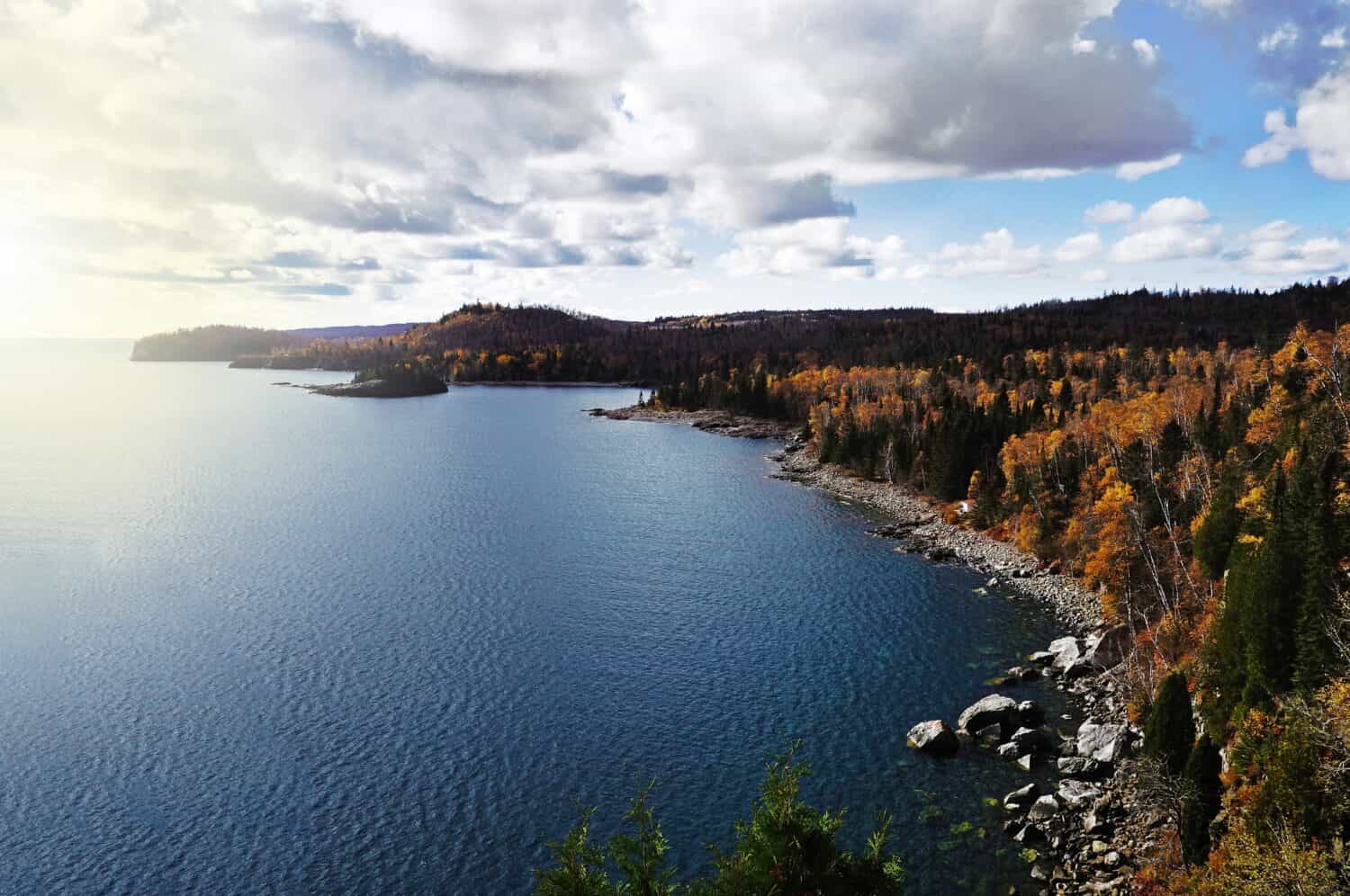Lake Superior, the largest of the Great Lakes, is a remarkable body of water boasting many superlative features. Not only is it the largest freshwater lake in the world by surface area, but it also constitutes the most substantial freshwater system globally when combined with the other Great Lakes. Spanning nearly 32,000 square miles, Lake Superior is second only to the Caspian Sea in size. More than 20% of all the world’s fresh surface water is held within the Great Lakes. Half of that amount is contained in Lake Superior alone. That means it holds a staggering 2,900 cubic miles or 3 quadrillion (a three followed by 15 zeros!) gallons of water.

The Great Lakes region serves as a primary water source for more than 40 million people. It also accounts for more than 90% of the fresh surface water in the United States. Further, it acts as an important shipping route, tourist attraction, and energy source.
Comparisons with Other Bodies of Water and Other Fun Facts
Lake Superior stands out even among other large bodies of water. It is the world’s largest freshwater lake by surface area. In fact, it holds more water than all the other Great Lakes combined, with room to spare for three more Lake Eries. The entire Great Lakes system is the largest freshwater system in the world. Lake Superior alone, though, contains half of the water in all the Great Lakes.

Lake Superior contains half of the water across all of the Great Lakes.
©iStock.com/Todd Hogrefe
When compared with the Caspian Sea, the world’s largest lake by volume and surface area, Lake Superior still holds its own. The Caspian Sea has a surface area of around 143,244 square miles (or about 371,000 square kilometers). That makes it about 4.5 times larger than Lake Superior in terms of surface area. However, the Caspian Sea is a saltwater lake, leaving Lake Superior as the GOAT of freshwater lakes.
The staggering depth of Lake Superior is another noteworthy attribute. It plunges to 1,330 feet at its deepest point. That depth is so great that if the Empire State Building were placed at this point, only the antenna would be visible above the waves. Further, the lake takes almost 200 years to fill with new water, a testament to its enormous volume.
The lake is also immense in its horizontal dimensions. It’s 160 miles (257 kilometers) wide and about 350 miles (563 km) long. That’s roughly equivalent to the distance between New York City and Pittsburgh in length. It’s equivalent to the distance between San Francisco and Los Angeles in width.
Indeed, if every human on Earth (estimated at around 7.9 billion people as of 2023) were to consume a gallon of water from Lake Superior every day, it would take over a thousand years to drink all the water in the lake. That’s assuming that the population doesn’t grow, and no other water enters the lake.
In fact, if an average person drinks about half a gallon (approximately 2 liters) of water per day, the calculation edges on the absurd. At that rate, it would take them 6 quadrillion days to drink all the water in Lake Superior. This translates to about 16.4 trillion years. That is a span of time over 1,180,000 times longer than the current age of the universe, estimated at 13.8 billion years. Thus, one can say with confidence that it is absurdly big.
Taking us back down to Earth, it also (jokingly) hosts a variety of whales, as documented here.

If every human alive drank a gallon of Lake Superior water every day, it would take over a thousand years to empty it.
©zimmytws/Shutterstock.com
Geologic, Anthropological, and Economic History
Lake Superior’s formation dates back about 1.2 billion years, attributable to the North American Mid-Continent Rift. The area saw its first settlers around 8,000 B.C. By the early 1600s, the Ojibway tribe had established a village on Madeline Island. (They called the island Mooniingwanekaaning-minis, or the “island of the yellow shafter flicker.”) French explorers arrived in the mid-1600s. It was they who named the lake “Superior.” This was to signify its size and position as the northernmost of all the Great Lakes.
The lake has been a significant mode of transportation since at least Colonial times, playing a pivotal role in the fur industry and other trading activities. Today, it remains a crucial shipping hub, albeit one prone to maritime accidents due to varying depths and unpredictable weather. Its many shipwrecks are well-documented here.
Given its size, the biodiversity of Lake Superior is appropriately astounding. Around 80 species of fish, including varieties of trout, salmon, and perch, inhabit the lake. The region is also home to many common native plant species and hosts nearly 60 orchid species. Birdwatchers often delight in the varied hosts of hawks, loons, owls, and woodpeckers that inhabit the area. A sedge of the naturally rare endangered whooping cranes also resides along the lake’s north shore.
The Lake Superior Watershed, which is part of the Great Lakes-St. Lawrence Watershed, while large, is also a sensitive ecosystem. The depth of the lake means that it takes 400-500 years for a complete water change. The same drop of water that enters Lake Superior will need 191 years to empty into the St. Mary’s River.
In terms of economic importance, Lake Superior plays a significant role. Its basin is home to several rich natural resources, including iron ore, copper, nickel, and silver. The extraction and processing of these resources have led to the development of many communities in the region, providing jobs and contributing to the economy.
Conclusion
Despite its size, depth, and grandeur, like all precious bodies of water, Lake Superior holds a delicate balance. Its intricate history, shaped by tectonic forces and the ceaseless march of glaciers, has given us a water body of unparalleled depth and clarity. Yet, this same history underscores its vulnerability. The lake’s temperatures, water levels, and biodiversity are all finely tuned to climatic conditions. Changes brought on by human activity and global warming pose serious challenges to this sensitive balance. The longevity of Lake Superior and its continued ability to support life and serve as a valuable resource hinge on our commitment to sustainability and conscientious stewardship.
Thank you for reading! Have some feedback for us? Contact the AZ Animals editorial team.








